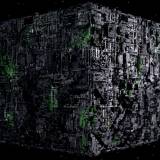All Saturn Games In Order: January 1996
By borgmaster 5 Comments
An explanation of what I'm doing here can be found in my introduction post.
Last we saw of each other, we were wrapping up the PS1 releases from March '96 with Wing Commander III: Heart of the Tiger, Road & Track Presents: The Need for Speed, Extreme Pinball, and Resident Evil. Also, we closed out the 3DO in '93 with Star Wars: Rebel Assault, Stellar 7: Draxon's Revenge, The Life Stage: Virtual House, and Twisted: The Game Show, but the less said about those the better.
We previously left the Saturn in December '95, when we looked at Bases Loaded '96: Double Header, Center Ring Boxing, Gex, Valora Valley Golf, Hi-Octane, FIFA 96, Mystaria: The Realms of Lore, and Thunderstrike 2.
This time we're entering the future of 1996 with the January releases of Wing Arms, NFL Quarterback Club '96, Mortal Kombat II, World Cup Golf: Professional Edition, Darius Gaiden, and Hang-On GP.
**This post is also featured on my site, fifthgengaming.blog, and can be found here.**
----------------------------------------------------------------------------------------------------
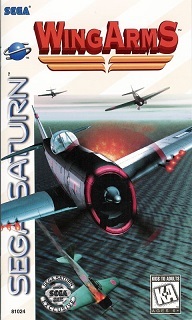
Wing Arms
Developer: Sega
Publisher: Sega
Release Date: 1/5/1996
Time to Sinking Not-The-Yamato: 85 Minutes
We start the year off with a first party game that had already come out in other regions the previous Fall. I'm not sure what delayed the release of this version, but it's a welcome sight during the January morass. Wing Arms is a Flight Combat game that takes some, let's say creative, liberties with its late-WWII setting. While Sega arcade games of this period have the same kind of three mission structure, their console action games seem to be developing their own six mission structure. Though unlike Panzer Dragoon, this game lets you see the ending on default settings.
I'm not overly fond of the premise, so let's get that out of the way first. The year is 1945 and some international super-villain conglomerate has cobbled a military together to fight the recently exhausted major powers for world domination for some reason. These villains pull off a Pearl Harbor 2: Electric Boogaloo, leaving only one allied aircraft carrier left in fighting condition. That carrier is somehow operating planes from every major air power of WWII, including US Navy Hellcats, US Army Mustangs, British Spitfires, Japanese Zeros, and German Messerschmitts among others. While this gives plenty of gameplay variety, maybe they shouldn't have cobbled together a plot justification for axis and allies to buddy up. Anyway, using your chosen plane you go through six levels of dogfights, base attacks, and ship attacks.
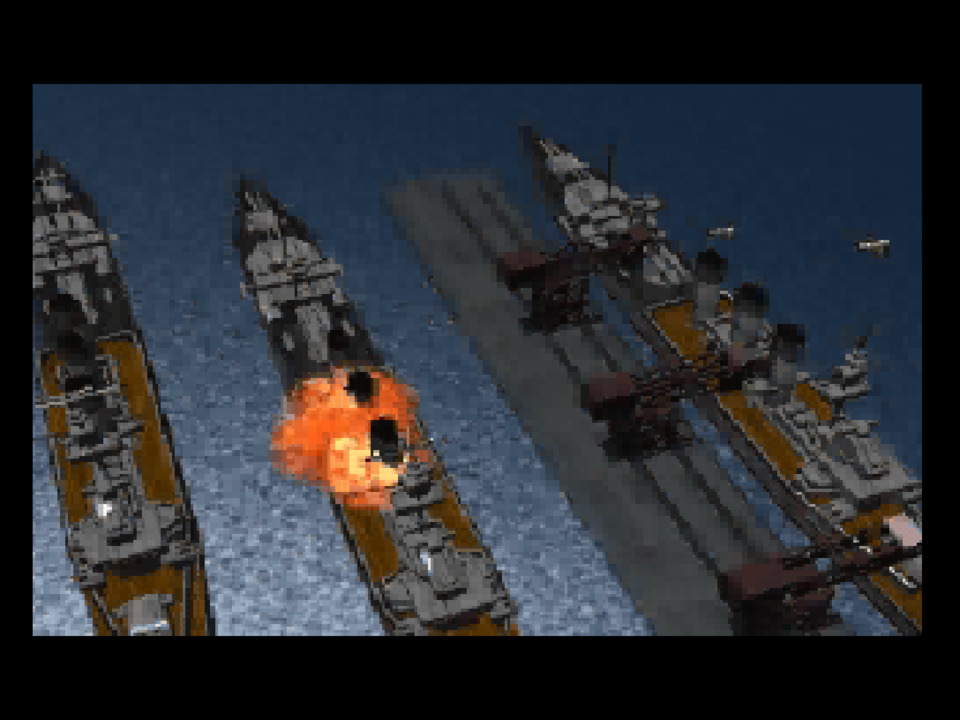
Being a WWII-era Flight Combat game, your only weapons are your guns that can overheat and a limited, non-refillable supply of dumb rockets. You have a simple radar, useful map, altimeter, and level completion counter as UI elements in all views, with the speedometer and reticule reserved for the cockpit view for some reason. I played most of the game from the third-person perspective until I realized the cockpit had more information. Being a first party Sega game, the thing looks good, sounds good, and controls well. The game gives you a flight ceiling of about 1000 feet, which is enough for the purposes of the gameplay. The difficulty ramp is also highly reasonable, and I was able to beat the thing with only a couple of bumps. Fundamentally, this is one of the best games so far for the Saturn, which is why I will commence the nitpicking.
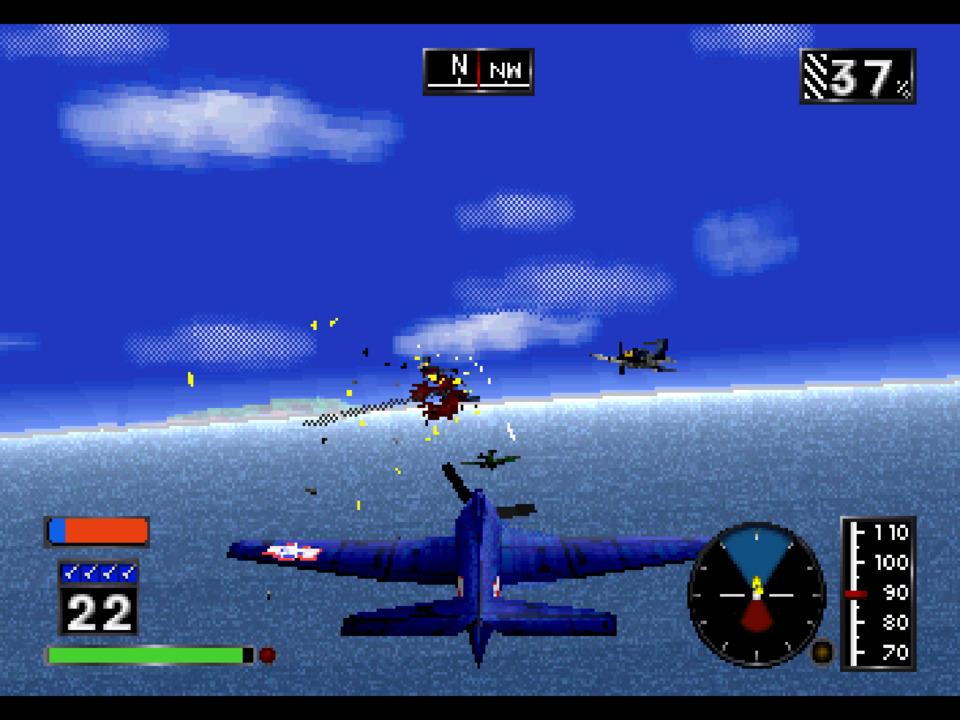
This thing is good enough to have Air Combat serve as the main point of comparison, to its misfortune. The immediate point of comparison is the draw distance. While Namco's game was awesome with its polygonal sightlines, Wing Arms fares worse. Objects only pop into existence when they're less than a hundred meters or so away, which is a bit too short for navigating interceptions or attack runs. Also, there isn't as much gameplay variety as you would want from a game with only six missions. The first mission is all dogfighting, which is fair enough. The second mission is to kill a weird oil rig shaped base and a Shokaku lookin' motherfucker. Next is a canyon maze where you have to chase down half-a-dozen planes, this is the worst section, and a desert level where you have to kill two bases identical to the first one. The fourth mission is more dogfighting and killing some destroyers and a cruiser. Next is a worse version of the Air Combat final boss in a night level, this is the second worst section. Finally, you kill one more base and the superbattleship Yamato the bad guys' scary super-duper weapon. The game switches between air/ground combat frequently enough, but with only one loadout, there's only so much variation in what you can do. You could probably say that about any Flight Combat game, but it does feel like something is seriously missing from this experience.
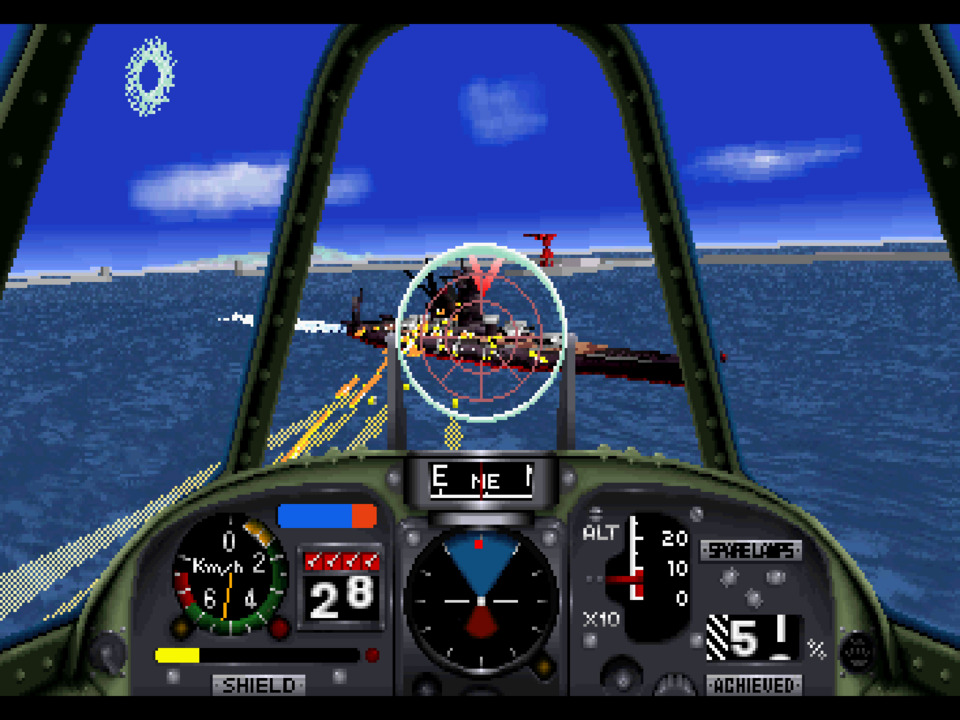
There's not a ton else going on here. You have a kind of scoring system, but being a single-player console game, it could not matter less. There's some unpacking that you can do around the premise. A Japanese studio making a game where the axis and allies of WWII team up to fight a rogue military that possesses Japanese naval assets and a literal airship, which is basically an AC-130 with a death ray and can launch infinite rocket interceptors. I don't have the time or ability to fully address the thinking behind these creative choices, but I can raise an eyebrow and point them out. Otherwise, this is the second-best flying game I've played so far for these consoles, which is a position that has a lot of distance to both first in front and third behind.
----------------------------------------------------------------------------------------------------
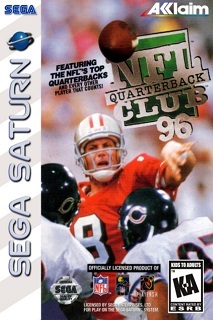
NFL Quarterback Club '96
Developer: Iguana Entertainment
Publisher: Acclaim
Release Date: 1/18/1996
Time to An Incomplete Pass: 27 Minutes
We now have the first real Football game for the Saturn. I'm not counting Quarterback Attack with Mike Ditka because doing so would require grappling with that thing’s existence, which I'm too sober to attempt. Though I'm mildly reluctant to give this game too much credit, being an up-ported 16-bit game. Also, I am under no obligation to respect Acclaim's in-house sports franchises, which we will have more than ample opportunity to talk about in the future.
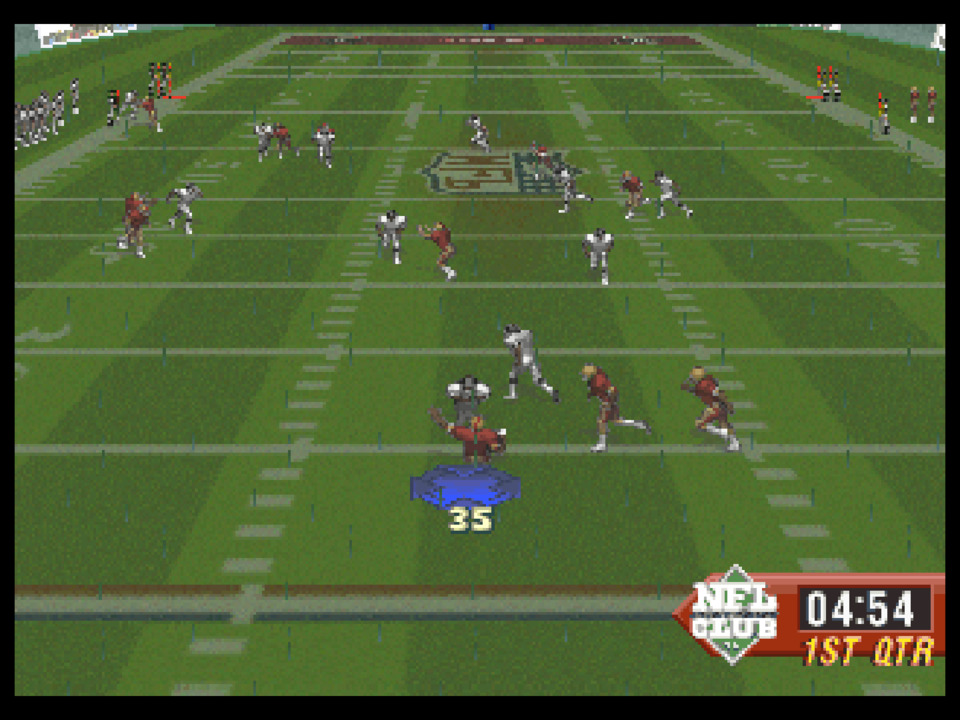
So, what does this cross-gen also-ran Football game have to offer? All of the standard features and expected gameplay that can be seen in other end of life SNES sports games. It also exists on a platform that Madden has failed to reach, so it's your best option by default. You have single game, season, and multi-player modes to work with. In the matches themselves, you choose plays and try to throw the ball around. Like with my short time playing NFL Gameday, I'm completely lost in all aspects of the gameplay. Though, I think I'm getting better, since I was able to figure out how to pass the ball and I even completed one whole entire pass in the three quarters I played. If I had more than 1.5 seconds to throw the ball before getting sacked, I could probably get a better hang of the gameplay. Yet, such as it is, this is definitely Football.
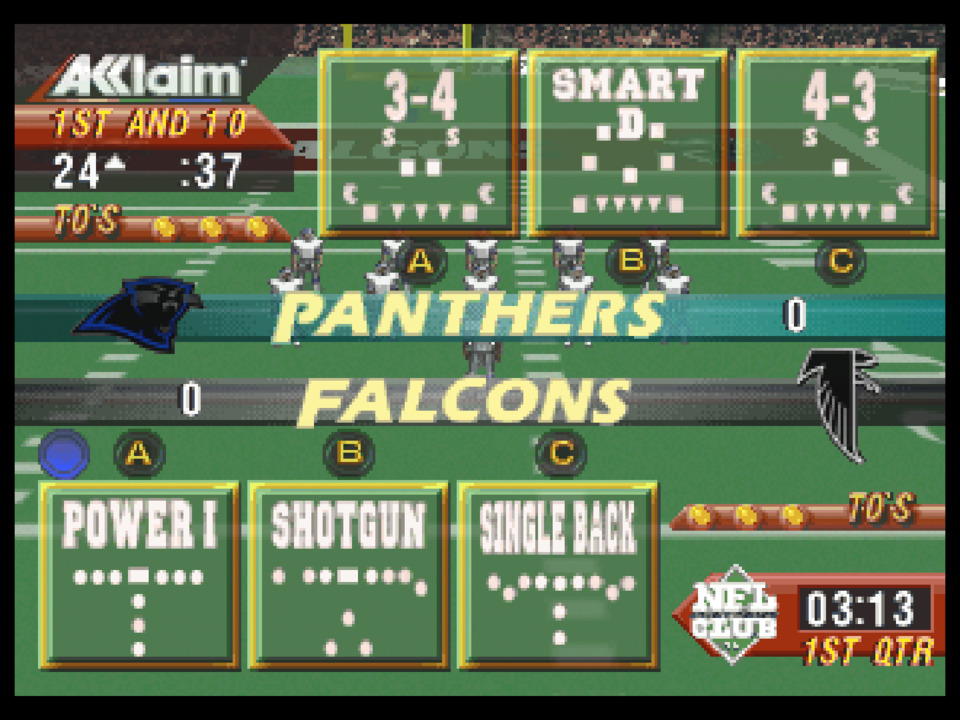
There are probably all kinds of things that can be dug into with the gameplay of the Quarterback Club series versus its competitors, the new features here compared to the previous year, and even what the generational transition meant for this genre. I am wholly unequipped to do any of that. As far as I can say, this is much less polygonal than NFL Gameday, but it seems to be more feature rich, and I was able to figure out how to play it slightly better. So, I guess this is the best Football game so far for either the Saturn or Playstation. Yay?
----------------------------------------------------------------------------------------------------
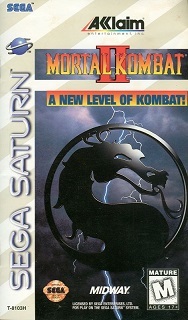
Mortal Kombat II
Developer: Probe Entertainment
Publisher: Acclaim
Release Date: 1/23/1996
Time to Fine, I Didn't Want To Play This Stupid Game Anyway: 8 Minutes
While we're dealing with Acclaim, we might as well get this out of the way. Before talking about the game itself, I want to revel in the hilarity of this ports existence. Even though this game was less than 2.5 years old at this point, UMK3 has been out in arcades for a couple of months and vanilla MK3 has been on the PS1 since the previous October. While there are plenty of people these days who would go to bat for MKII over MK3, this was still a massive show of weakness for Sega in '96. This game had already been ported to the SNES, Game Boy, 32X, PCs, and the Master System by this point. The Saturn version was apparently the closest to being arcade accurate of all of these, but would that have mattered this late in the scheme of things?
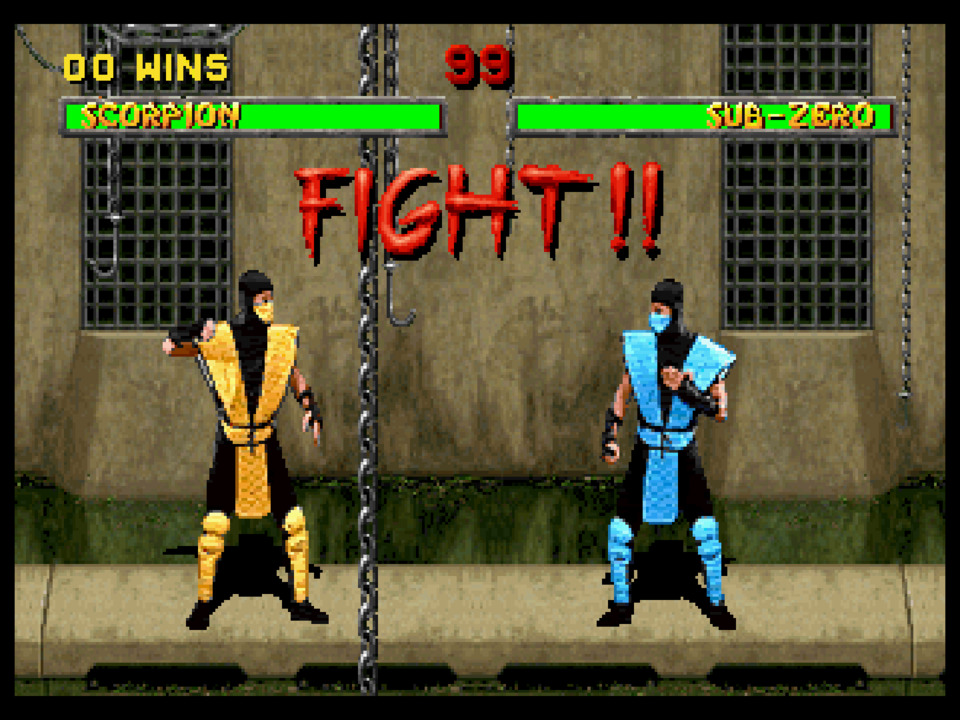
So, how is the game itself? It's literally Mortal Kombat II with CD loading times. This is almost impossible for me to review for two interconnected reasons. First, this is intended as a two-player game more so than just about any other fighting game we've seen thus far, and playing it alone is literally doing it wrong. Second, because I didn't spend the mid-90's gitting gud at Mortal Kombat with my local arcade delinquents, the brutal AI of the fight ladder presented an immediate and overwhelming difficulty wall. How many times can I get instantly eviscerated by the first fight in a ladder before I go do literally anything else with my time? At least in the PS1 release of MK3 I was able to get to the second fight. There's literally nothing in here but the fight ladder and two-player, so there's nothing for me to do. Also, if someone cared enough to be good at these games, they had probably already moved on to the next one by this point. There's basically nothing to recommend this thing either at the time or in retrospect.
----------------------------------------------------------------------------------------------------
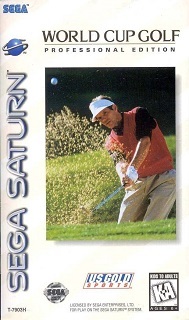
World Cup Golf: Professional Edition
Developer: Arc Developments
Publisher: U.S. Gold
Release Date: 1/24/1996
Time to Another Disastrous Hole: 22 Minutes*
Arc Developments will haunt me to my dying days. How does the (at time of writing) worst PS1 game fare on the Saturn? Exactly the same! If anything, Arc has accomplished the task of creating the exact same experience on both consoles. This is probably because this wretched thing was originally a 3DO game and was thus non-taxing to both systems. Still, I wish there was something different going on here.
To reiterate, this is a single course golf game full of Hyatt branding that was originally a 3DO game from 1994. Other than being a piss poor representation of the Dorado Beach golf course, it's also a disastrously bad Golf game. Since this is my second experience with the thing, I've developed a more focused opinion on where this all goes horribly wrong. I'm not going to harp that much on the presentation, because it looks passable by 3DO standards, which was the original context for the game. Instead, let's zero in on the act of moving the ball around.
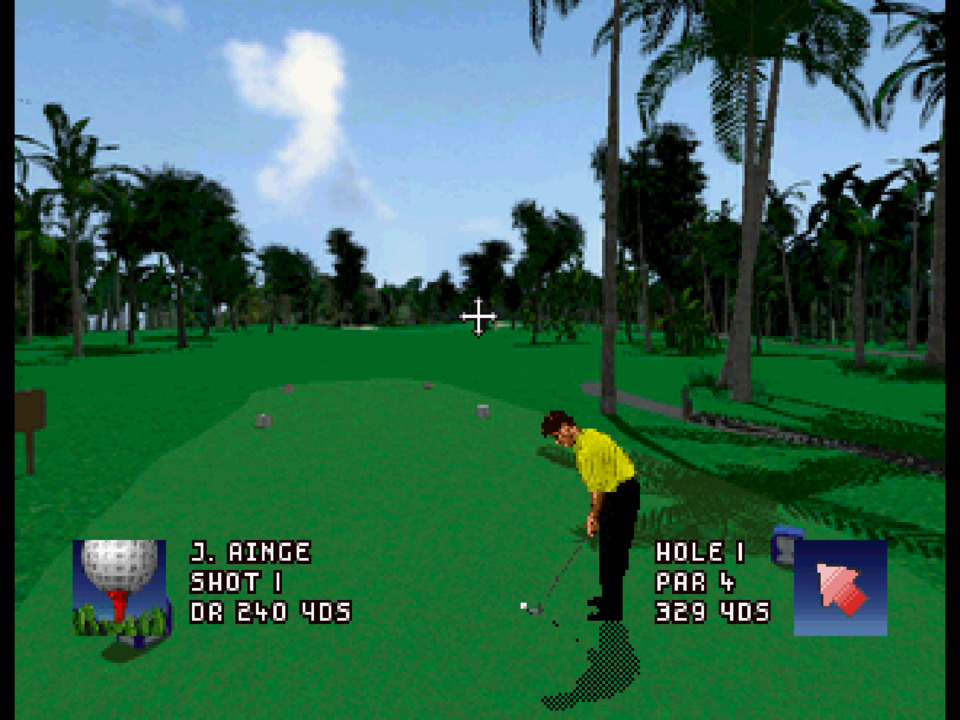
I described the horrific shot mechanics in my previous review, but let's dive in a bit more. The simple fact that you have to move a cursor around on the screen from a behind the back view is a hideous design choice. Humor me for a bit. When you look at a 2D picture of a piece of landscape that extends off for some distance, any arbitrary pixel in that photo is going to represent a spot in 3D space that is a different distance and elevation from the viewpoint and any other pixel. The greater the distance being imaged, and the fewer number of pixels used to do so, the greater the area represented by each pixel. Because of the nature of image depth, the area represented in each pixel is going to increase the further away it is from the viewpoint. The native resolution of the original release of his game was probably somewhere around 240x320, with only a third to half of the screen representing the terrain in front of you. Using those pixels to aim down a golf course up to 300 or so yards away is unfeasible. There is no way to make that aiming system work, and the only thing more inexplicable than the devs attempting it was the publisher greenlighting the final product. Your brain has to be really Amiga-poisoned to do that kind of thing.
I'll save the rest of this rant for when I inevitably have to play this thing again for the 3DO series. I'm going to make a badly considered promise. When that time comes, I'll stream myself failing miserably at all 18 holes.
----------------------------------------------------------------------------------------------------
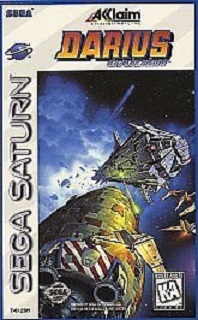
Darius Gaiden
Developer: Aisystem Tokyo
Publisher: Acclaim
Release Date: 1/29/1996
Time to Killed By A Space Fish: 19 Minutes
Another week, another 'shmup. This time we have the honor of getting smacked around by Taito's flagship Shooter franchise, Darius. The original Darius, released to arcades in 1987, was the result of developers at Taito looking at Gradius and saying, "but what if it was w I d e r". The damn thing used a three-screen arcade cabinet, which created a big 'ol pain in the rear for everyone who had to either port, emulate, or do cabinet upkeep on the thing. It also did one up on the other big 'shmups of the time by having branching paths after every level, which meant you could only see 7 of the 28 stages in a single run, though all the stages in the same tier tend to share enemies. 1989's Darius II would keep the unique game structure but scale down to a two-screen display, making it slightly less of a pain in the rear. After this Taito realized that console games made money and they proceeded to put some graphically reasonable entries on home systems for a while.
That is until round about 1994, when one of the younger designers at the company got the idea that Darius III would be good to showcase the power of Taito's new arcade board. The biggest innovation here, other than polygons and high-quality audio, was putting it on one screen like a normal goddamn video game. The design and artistry going into the production were all completely sound, though the name would be changed to Darius Gaiden for lore reasons. A year and a half after its release in arcades, we now have to deal with it on the Saturn.
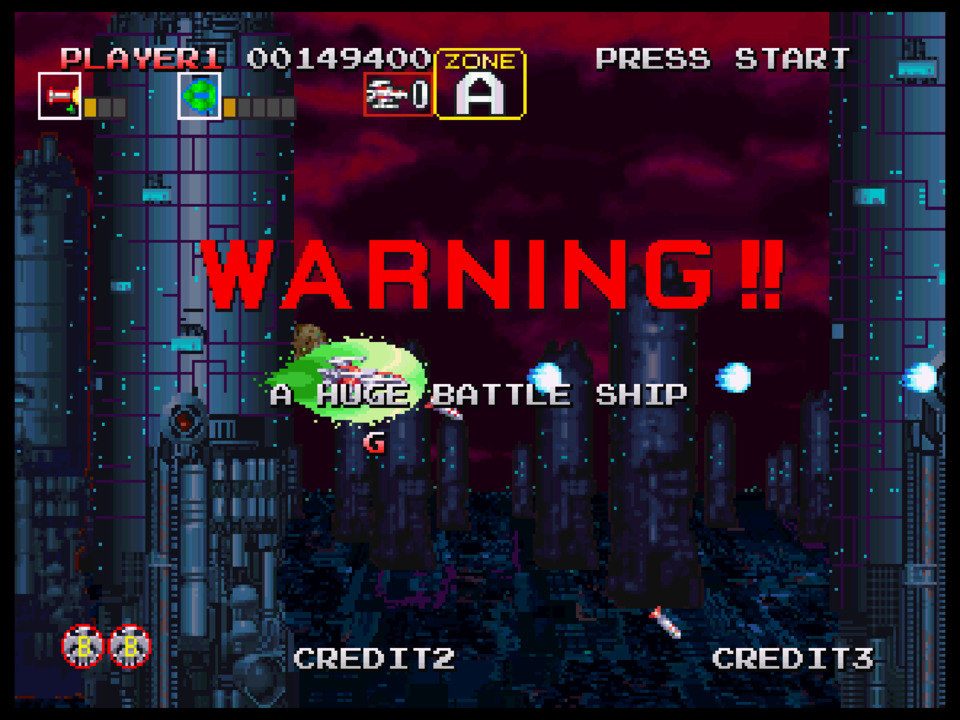
The premise involves some space stuff about people moving planets because of aliens flying around in giant angler fish or something. No matter how many times I look at the lore of the Darius series, it never sticks. Though I do remember that this takes place between the first two games, which is why it's Gaiden and not III. Regardless, you fly a ship horizontally through seven stages, with branching paths at the end of the first six. This is still a neat way to structure a 'shmup, even in our more advanced era. The environment and sprites themselves look good in a way that makes me think of well-produced GBA games, which is also a vibe I got off of Astal. I also dig the music, which I have a hard time describing, but it works well when combined with the sound effects and overall visual flow. Take a listen to it below and come to your own conclusions.
So, the structure is neat, and the presentation is top notch for its era, but video games have to be played. As you would probably expect, this game is hella fucked. There are two main reasons for this. Well, there are three, but 'shmups being inherently fucked hard is a given so I'm not counting it. The first thing is that you only get three continues to last for an entire playthrough. I've gone off repeatedly about strict continue limits, and I will never stop. That issue is compounded by this thing being a proto-Bullet Hell game. It doesn't go full Ikaruga, but it also ain't Gradius either, if you know what I mean. So, you're dodging a bunch of bullshit and you don't get to make that many mistakes. That's a long way of saying that I didn't get past the third tier of stages. There aren't any other modes going on, so it's either bang your head against this thing and memorize a path or go do something else.
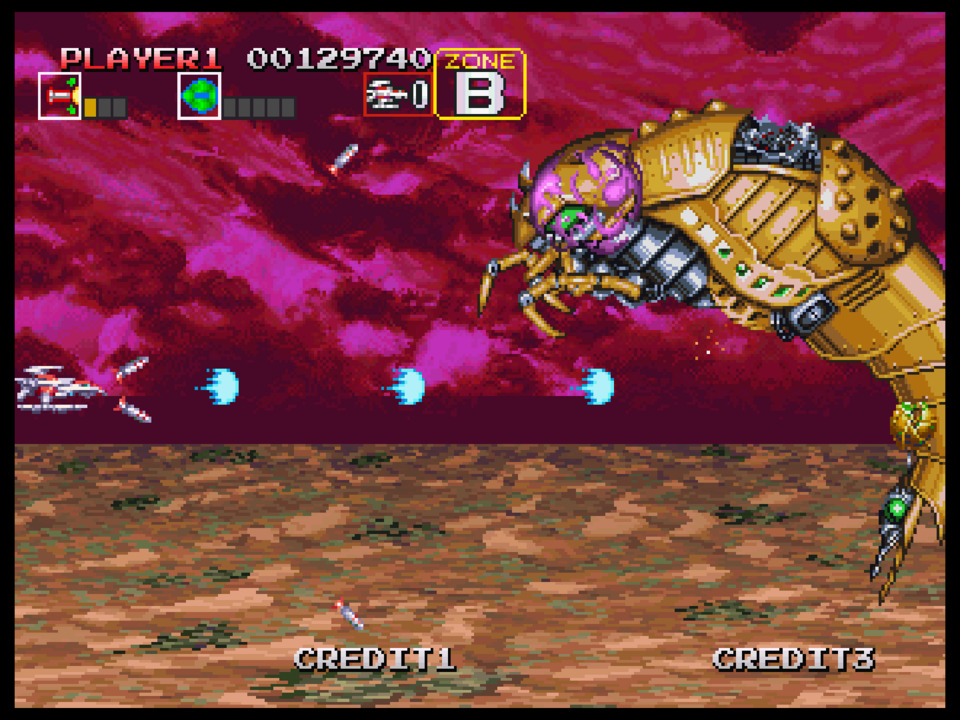
Like with Taito's previous Saturn Shooter, Galactic Attack, the presentation is good but playing it is a chore. Between these two games and In the Hunt, I'm starting to have that as my default opinion for the entire genre. This thing reviewed well in its time and was successful enough for what it was, but the market for 'shmups was starting to dry up and the genre was trending towards the insularity of Bullet Hells. This game is either one of the last hurrahs of old Shooter design, or the beginning of the end. I'm not an expert of the genre, so I'll just continue to suck at these while complaining about continues.
----------------------------------------------------------------------------------------------------
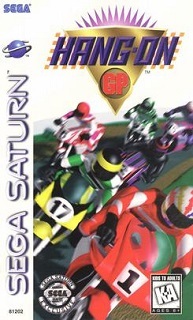
Hang-On GP
Developer: Genki
Publisher: Sega
Release Date: 1/30/1996
Time to Bouncing Off A Wall: 20 Minutes
Finally, we have to deal with this. What would Hang-On be without the motorcycle cabinet or Yu Suzuki? Not much, apparently. Hang-On GP is the third and final game in the otherwise vaunted series and the first to not be directly developed by Sega. I've just now realized while looking into this developer, Genki, that they made both Kileak and Robotica, and I have no idea how I missed that detail before now. Why in the hell did Sega give the Hang-On license to the frickin' Kileak people? The universe is a mystery like that sometimes.
That's all beside the point of the game itself. This is an arcade-style Racing game, but notably this is not a port of an arcade game. We're dealing with a Saturn original here. There are three race environments with two track configurations (short and long) each. You can't race on the long tracks without placing at the top of the race on the short tracks. You have ten bikes to choose from that each have different stats, so there's that at least. Finally, you can go around the tracks in either Time Trial or Race modes. That's it. There seems to be some minor unlockable stuff for beating the long races, but it isn't much. There just isn't a lot going on here.
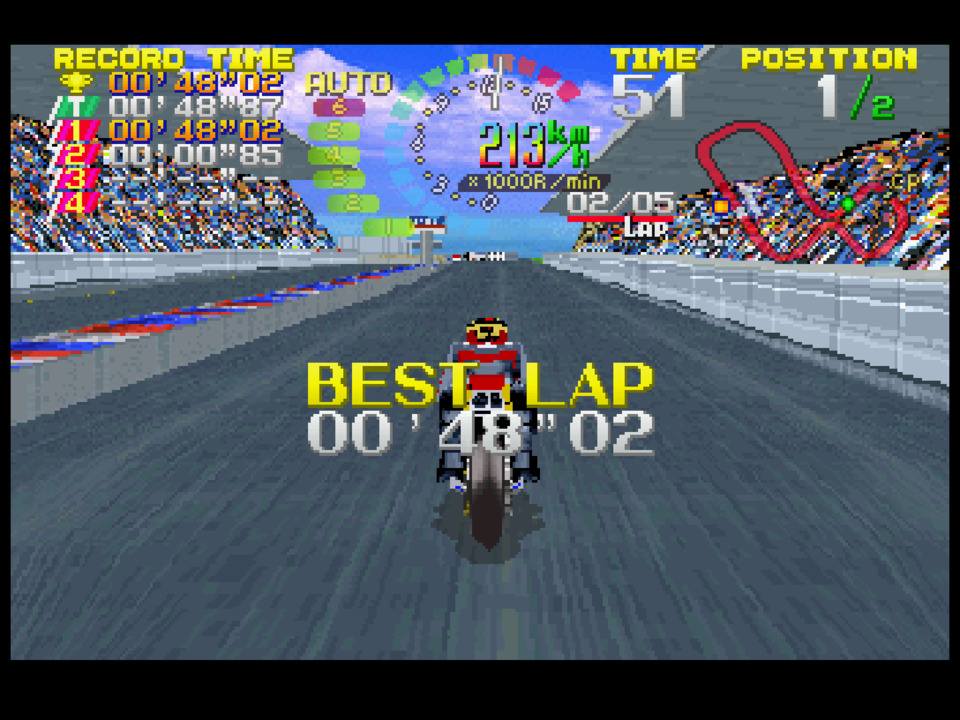
So, there isn't much here, but is it fun? Not really, but it also isn't that miserable either. That isn't to say it's bad, I've just never been a fan of the way Hang-On games feel. The way these games handle turning has always felt terrible to me, and this one didn't disabuse me of that feeling. If you can get a handle of the controls, then it ends up being like Daytona USA but for motorcycles. The textured polygons look ok, but the draw distance isn't awesome, and while the graphics are more stable than in Daytona or Cyber Speedway, that also isn't saying much. The music also occupies that awkward space where it's good but not great or memorable. Hopefully this all sounds as meh as it felt. The thing feels like a scaler race, but it was developed in '95 when you couldn't get away with that anymore.
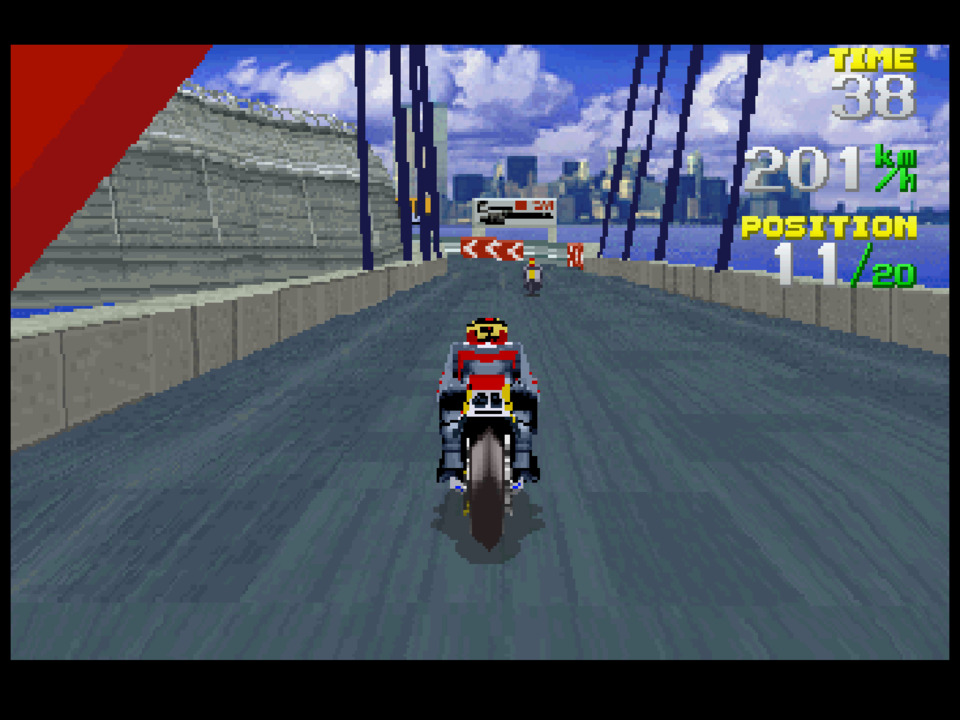
There is a weird quirk where after every race the game asked me to input initials, but then it didn't surface any kind of leaderboard and instead kicked me to the title screen. I even dug around to look for a scoring or timing board but didn't find anything. Maybe you only get to see it by winning a race, which I never did. If it's '96 and you could get this game for a discount, it could have been a good way to kill time. Reviewers at the time were as nonplussed then as I am now, and this game seems to have made no impact on anything. That's kind of insane, considering how big a deal the first two Hang-Ons were. This series went out not with a bang, but a shrug, which is a bad omen for the Saturn.
----------------------------------------------------------------------------------------------------
January is now done and dusted, and we were fortunate enough to have some games that missed the '95 holiday season to keep us company. Though, the presence of World Series Golf is a harbinger for the months to come. Ah well, early '96 was a bad time for video games all around so we can't fault this console too much…YET.
Let's pull the Ranking of All Saturn Games out of storage and see where this all fits:
1.Panzer Dragoon
…
5. Wing Arms
14. Hang-On GP
21. Darius Gaiden
26. NFL Quarterback Club '96
46. Mortal Kombat II
53. World Cup Golf: Professional Edition
…
54. The Mansion of Hidden Souls
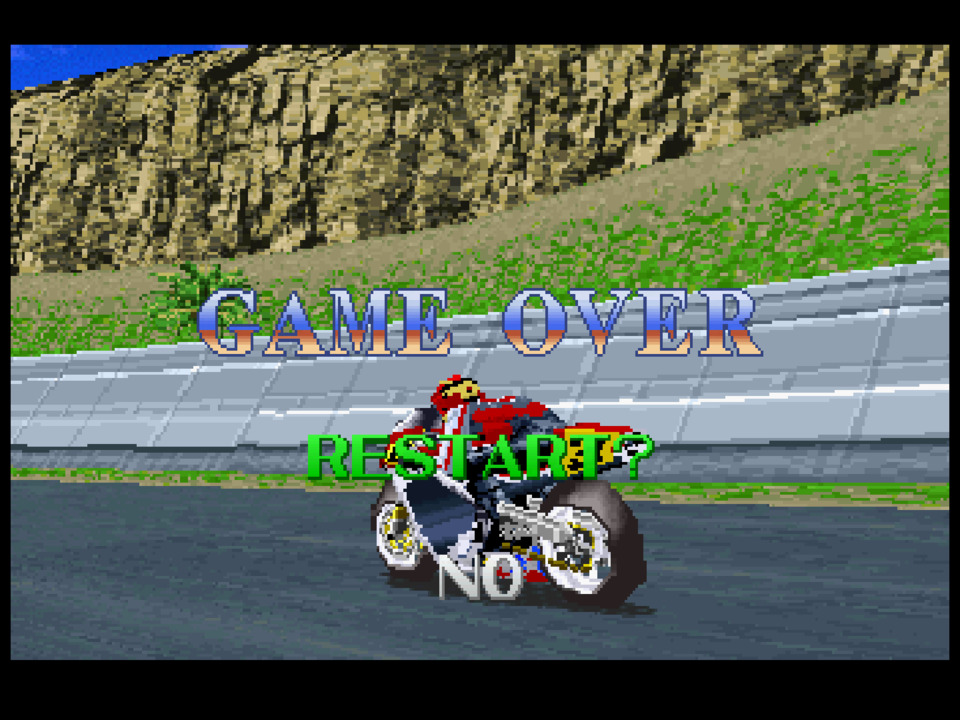
On Friday we'll dive into the kiddie pool that is the Atari Jaguar game catalog when we look at every game released for the thing in 1993: Cybermorph, Trevor McFur in the Crescent Galaxy, Evolution: Dino Dudes, and Raiden.
Next week we'll be back on our bullshit with the Saturn when we look at its February '96 releases of Street Fighter Alpha: Warrior's Dreams, Cyberia, The Horde, Clockwork Knight 2, Defcon 5, College Slam, and Johnny Bazookatone. Arc Developments will haunt me to my dying days.
----------------------------------------------------------------------------------------------------
I streamed these games over on my Twitch channel at https://www.twitch.tv/fifthgenerationgaming. The archive can be watched below.
